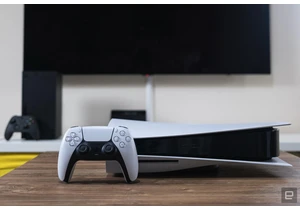My dream projector delivers the brightest and sharpest image. But it also has to be easy to move around and set up anywhere — especially outdoors. Anker’s Nebula X1 long-throw projector promises all of that with a three-laser engine that beams out a category-leading 3,500 ANSI lumens at 4K resolution. It also has features never seen before on a home projector, like liquid cooling to reduce fan noise and a motorized lens gimbal that automates setup. Plus, it offers good sound that can be upgraded with optional satellite speakers.
The rub is the price. At $3,000 ($3,298 with the satellite speakers for a limited time) it’s one of the more expensive consumer projectors, right up there with models like Epson’s LS11000 or the Valerion VisionMaster Pro2. After testing it, I can say that it offers the clearest, most vivid image quality I’ve seen and has the simplest setup to boot. However, the high price puts it far out of reach for most portable projector buyers.
Features and design
The Nebula X1 follows in the footsteps of other Anker projectors, like the original Nebula and Cosmos, with a tall rectangular design and handle that neatly retracts with a press. While that makes it easy to carry, it also means the Nebula X1 hangs down more than most indoor projectors when ceiling-mounted.
To eliminate the tedious setup that typically plagues projectors, Anker did a clever thing: it placed the lens mechanism on a gimbal that can tilt up to 25 degrees. When combined with a 1.67x zoom, autofocus, keystone correction and ambient light detection, the projector fully automates setup. First, you have to choose a screen or wall location and position the projector at a prescribed distance between 8 and 35 feet, depending on the screen or wall size. You should center the projector as well as you can to avoid any digital (keystone) correction that can adversely affect image quality. Then the magic happens at the press of a button.
The Nebula X1 uses a function it calls Spatial Adaptation to scan the area in front of it. The lens tilts up and down, before displaying a checkerboard pattern and then beaming the final image pretty much precisely where it should be. It’s not perfect, as some obstacles like small plants or fine wires can throw it off, but it worked nicely for me on both a wall and dedicated screen. The projector can adapt to ambient light and even the wall color, and another function called Spatial Recall lets you save those settings for frequently used locations.
Laser engines get hot and are normally cooled with fans that can generate distracting noise. However, the Nebula X1 is the first consumer model with liquid cooling which reduces fan noise to a barely audible 26dB whisper. Thanks to this cooling system, the projector can also have a smaller footprint. That’s a big quality-of-life improvement compared to much of the competition.
As for inputs, the X1 comes with two HDMI 2.1 ports, including one with Enhanced Audio Return Channel (eARC) functionality. That standard supports fast refresh rates of up to 240Hz at 4K, though the X1 tops out at 4K 60Hz so it’s not ideal as a gaming projector. It also offers USB Type-A and USB Type-C ports, along with a S/PDIF optical audio port.
Google TV is built in for streaming and projector control. It provides a large library of apps via Google Play along with a familiar interface. You also get Netflix’s official application with support for 4K Dolby Vision without the need to plug in a streaming device, plus Chromecast support and Google Assistant for voice control. The downside is that it can occasionally be sluggish, particularly with menu settings like projector image control.
Image quality
Anker uses what it calls “cinema-grade glass” in the Nebula’s 14-element lens to increase brightness, color accuracy and lens durability. The 4K triple laser engine is rated at up to 3,500 ANSI lumens with a 5,000:1 contrast ratio. At the same time, it offers color accuracy with a Delta E value of less than 0.8 and an impressive 110 percent of the Rec.2020 color spectrum, matching high-end ultra short throw (UST) models from Samsung, LG and Formovie. That 4K Dolby Vision support I mentioned is also rare among the competition.
The result is the sharpest and brightest image I’ve seen on any projector in this price range. It was bright enough for me to comfortably watch a soccer match on a sunny day without the shades lowered. And if you switch it to Conference mode, you can ramp the brightness up further for a viewable image even with lights on, but there’s the downside of a slight blue color cast.
When used in a darkened room or outside at night, the Nebula’s image quality is the best of any projector I’ve tested. Even though it uses the same Texas Instruments 0.47-inch DMD (digital mirror device) as many other 4K models, the image is clearer and sharper thanks to the glass element lens. Contrast and black levels are also tops in this price range and not far off high-end projectors from JVC and Sony that cost twice as much. Once again, that’s due to the optics along with Anker’s 6-blade dynamic iris — another feature usually only found on high-end projectors — and the company’s “NebulaMaster 2.0” picture quality algorithm.
Color accuracy is outstanding out of the box in both HDR and non-HDR modes thanks to the ISF (Image Science Foundation) certification normally reserved for more expensive projectors. In fact, I found the color calibration nearly perfect on my unit in “ISF Night” mode. That meant images were close to how they were calibrated by the filmmakers for TV series and movies like Once Upon a Time in Hollywood, Andor, Dune 2 and Spider-Man: No Way Home. If the colors aren’t quite to your liking, you can make fine adjustments manually. Like many other 4K projectors of this type, the X1 has a slight amount of light spill around the edge of the image. However, it’s well-controlled and only noticeable when the projected image is particularly dark.
Sound
Anker put some extra work into the sound as well. Audio quality is solid thanks to the four built-in speakers with 40 watts total output. The lack of fan noise is a big help here. By itself, the X1 offers decent high-end and bass, but more importantly, dialog is easy to hear and understand.
For a big sonic upgrade, you can add a pair of Anker’s optional Nebula-branded satellite speakers that connect to the projector automatically via Wi-Fi. Each one has a pair of 40-watt front drivers, a 20-watt upward-firing driver and a 20-watt side-firing driver that combine to create a surround effect. Together with the projector, they deliver an impressive 200 watts of sound with Dolby Audio support (though not Dolby Atmos unfortunately). They’re also battery-powered with up to eight hours of use, which is especially handy for outdoor viewing. However, that also means you need to keep them charged.
To test these speakers, I selected several music-oriented movies including A Complete Unknown, Maestro and Rocketman, along with an action movie that has an impressive score and sound effects, Dune 2. In spite of their small size, the satellite speakers kept elements like music, dialog and sound effects crisp, clear and evenly balanced with powerful dynamic bass. You could certainly do better with a dedicated 5.1 or 7.1 surround sound system, but these speakers offer very respectable audio quality, are easy to set up and automatically sync with the picture. The X1 also supports other external Bluetooth speakers, but you may have to adjust the timing in the menus to ensure perfect sync for picture and sound.
Anker also offers a $4,000 package that includes a pair of its Soundcore microphones along with the speakers. Those also connect to the X1 automatically and let you use it as a very expensive karaoke machine. They provide clear sound but you don’t get the usual benefits of a karaoke setup like AI vocal removal and vocal enhancement.
Wrap-up
The Nebula X1 is an odd proposition. It’s marketed as a portable outdoor projector, but it also happens to be the best indoor projector I’ve ever tested. With an impeccably sharp, high-contrast and color-accurate image, the video quality is irreproachable. The ease of setup and overall size also makes it an outstanding choice if you want to move the X1 around. With the optional satellite speakers, it’s the best portable projector you can get, hands down.
The Nebula X1 doesn’t have a lot of competition in the portable category, apart from Valerion’s $3,000 VisionMaster Pro 2, which also has a 4K triple laser engine. However, the X1 beats that model on image quality, portability and ease of setup.
The thing is, most people looking for a portable projector won’t spend more than $500, let alone $3,000. So who is this for? I think it’s ideal for buyers looking at a UST or high-end long-throw projector who want a bit more versatility. Some may even use it as a standalone indoor projector as it can be mounted on the ceiling or on a stand. In other words, if you have the means, use it any way you want — it’s that versatile.
This article originally appeared on Engadget at https://www.engadget.com/home/home-theater/anker-nebula-x1-projector-review-the-king-of-outdoor-movies-if-you-can-afford-it-161519956.html?src=rss https://www.engadget.com/home/home-theater/anker-nebula-x1-projector-review-the-king-of-outdoor-movies-if-you-can-afford-it-161519956.html?src=rssMelden Sie sich an, um einen Kommentar hinzuzufügen






